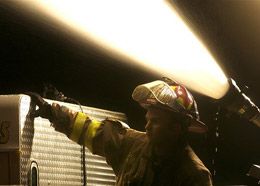By Cristi Laquer
FireRescue1 Staff
 AP Photo/Great Falls Tribune, Rion Sanders Firefighter Dan Wallace directs the spray of the main stream at a house fire in the rural town of Stockett, Mont., in November. Four rural fire departments responded to the blaze which destroyed the house. |
WASHINGTON, D.C. — The NFPA and USFA unveiled new measures Tuesday to reduce the high number of fire deaths in rural areas in the United States.
Communities with fewer than 2,500 residents have nearly twice the per capita incidence of fire death as larger cities, according to a report released by the two organizations.
They hope the report will help local authorities more effectively lead rural fire prevention efforts.
A major contributing factor in rural fire risk is physical spacing between structures, according to the study. Communities and individual homes tend to be further from one another in rural areas, making fires more difficult to combat and information about prevention more difficult to disseminate.
Low population density also negatively impacts the economies of rural communities, and most rural residents are at the lower end of the economic scale, the report said. Those living in poverty are at an increased fire risk because of their limited access to newer, safety technologies, such as smoke alarms. Some media, such as cable television or satellite radio, which may be the only effective source of information in isolated areas, are also prohibitively costly, it added.
“As communities with fewer than 2,500 residents have a per capita fire death rate almost twice the national rate, this is an important life safety effort,” said Gregory Cade, U.S. Fire Administrator.
“USFA has a long commitment to reducing fire deaths in this country through effective mitigation and preparedness.”
The NFPA and USFA have proposed adaptations to the three “E’s” of safety — education, engineering and enforcement — to reflect the specific challenges of rural fire safety:
- Education should address the causes of fire that are more threatening in rural areas. Heaters, electrical fires and outdoor burning cause many more fires in rural than urban areas, and safety education programs should specifically target these. Building fire safety education programs around existing networks, such as faith-based organizations, can be an effective way to reach a high percentage of a poorly connected community.
- Many rural structures do not have sprinklers or hydrant access, making firefighters’ jobs much harder. Fire officials are urged to work with local leaders to make fire safety a priority during the early stages of infrastructure and engineering planning.
- Enforcement of existing codes is another challenge in rural areas. The report states that 39 percent of communities with populations under 2,500 do not perform routine fire code inspections. This number is much lower in larger communities, ranging from 26 percent in towns of 2,500-5,000 to 1 percent for communities of more than 25,000. These gaps in enforcement mean that simply instituting new codes is often not effective in rural communities. Any safety program should be implemented through a channel that is likely to reach the entire community.
NFPA President James Shannon said he was pleased to be able to work with USFA on the innovative project.
“This initiative supports NFPA’s efforts in saving lives, protecting property, and reducing risks associated with fire,” he said.
Related Resource: Read USFA and NFPA’s “Mitigation of the Rural Fire Problem” |

